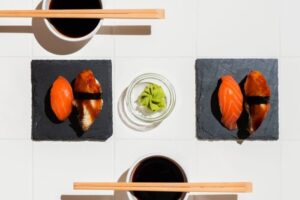What exactly is Wasabi?
Written by Lola Narawa on March 13, 2022

If you eat a lot of sushi and sashimi, you’re probably pretty familiar with wasabi. What is wasabi, though, other than that dollop of green paste on the side of your plate? This Japanese staple actually has an interesting history that you may not be familiar with, and it’s one of our favorite bits of food facts trivia.
Native to Japan, wasabi dates back to approximately 700 AD and was originally used medicinally as an antibacterial. In the 1100s, however, warriors began using the roots of the wasabi plant as a garnish on sashimi, either to add flavour to the fish or protect against bacteria. While their reasons aren’t completely clear to modern scholars, the warriors’ new use of wasabi caught on and stuck.
And that brings us to the wasabi you eat today…sort of. The crazy thing is that you’ve probably never even had real wasabi because it’s incredibly rare.
What is wasabi made of?
So what is wasabi, exactly? Real wasabi is made from the ground rhizomes (aka the stems) of the Brassicaceae mustard plant. The wasabi plant, called eutrema japonicum, is native only to Japan, though it’s been grown in smaller quantities in China, Korea, and the United States. It’s an expensive food because it’s limited, rare, and usually has to be imported.
The interesting thing about real wasabi is that once it’s exposed to air, it starts to lose its pungency. For this reason, real wasabi is grated right before it’s served so that it has more spice to it. It’s also naturally green. Imitation wasabi, on the other hand, relies on food colouring to give it that verdant hue.
Why is wasabi so spicy?
If you’ve ever had wasabi, then you know it can be a tad spicy on the tongue…and that’s putting it mildly. This is because of the thioglucosides in it. According to UCLA’s Science and Food site, thioglucosides are “sugar glucose with sulfur-containing organic compounds.” When you grind the stems of the wasabi plant, the cells break down, releasing the thioglucosides. This is why real wasabi is grated right before serving.
What does wasabi taste like?
It’s a bit tricky to liken the taste of wasabi to something else because it’s kind of in a class of its own, but it tastes fresh and spicy. Since the wasabi plant is part of the mustard family, it’s a bit similar to yellow mustard, though wasabi is a lot spicier. What’s interesting is that you’ll actually feel the spice through your nose almost more than you’ll feel it on your tongue. This is because much of the flavour and spiciness is released through fumes. When you eat it, you should feel its bite travelling through your nostrils and permeating your whole head.
What’s the right way to eat wasabi?
As mentioned earlier, wasabi traditionally has been eaten with sushi or sashimi to complement the flavour of the fish. More specifically, it can tamp down the fishiness of the fish, in addition to giving your palate a little kick. According to Nobu chef and founder Nobuyuki Matsuhisa, the best way to maximize your meal’s flavour is to dab a small amount directly onto your sushi and then lightly dip your sushi into soy sauce. So, if you’ve been mixing your wasabi in your soy sauce, that’s technically the “wrong” way to do it since it dilutes the flavour…but of course, it all boils down to personal preference, so you do you!





